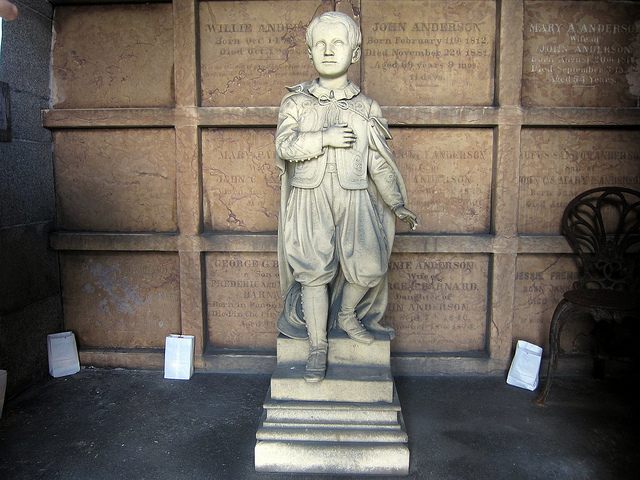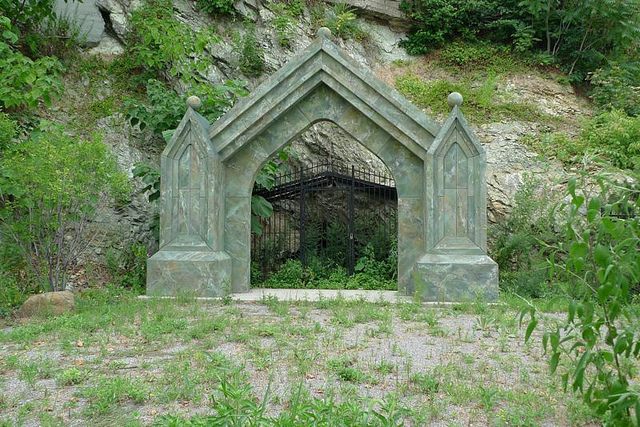The Mysterious Murder of the Beautiful Cigar Girl
31 Days of Halloween: On Atlas Obscura this month, we’re celebrating Halloween each day with woeful, wondrous, and wickedly macabre tales all linked to a real locale that you can visit, if you dare.

Mausoleum of John Anderson (all photographs by the author unless indicated)
The mysterious murder of Mary Rogers, known in the penny press as the “Beautiful Cigar Girl,” in the summer of 1841 remains one of New York City’s most infamous unsolved cases. Even Edgar Allan Poe took a crack at solving it, yet while her ghost is said to have visited the numerous suspects that the press circled after the beautiful young lady’s death, the truth of the grisly crime is still as murky as the Hudson River waters where her corpse was found.
In 1838, John Anderson, who owned a tobacco shop on Broadway in Lower Manhattan, hired Mary Rogers to stand at his counter purely to allure gentleman customers. It worked, and the dark haired beauty who was described as ”ethereal and hypnotically pleasing” made Anderson’s Tobacco Emporium one of the most popular in town. It had a regular clientele of notable figures like Washington Irving and, it’s stated, Poe himself, as well as a cavalcade of journalists, which would help to get her gruesome end its high profile in the press.
One day in October of 1838, Rogers went missing. Two weeks later, she suddenly reappeared, and many thought that Anderson had staged the disappearance for publicity. Rogers’ adoring fans swarmed the shop, and she soon felt overwhelmed and left to work in her mother’s boarding shop. Yet in July of 1841, she went missing again, and this time two men on the shore of New Jersey spotted her floating near Sybil’s Cave.

Sybil’s Cave (photograph by Walter Burns)
Built in 1832 to connect to a natural spring, Sybil’s Cave once offered cool water to visitors to the Hoboken shore. The visitors have long vanished, but in 2007 a new gate was built in front of the manmade cave. It’s here that many believe Rogers was murdered, although how is still a matter of speculation. The bruises on her body and ligature on her throat suggested gang violence or a vengeful lover (one of her many suitors, perhaps). From when her swollen remains were pulled from the water, each new clue or suspect was breathlessly reported in the tabloids, and the public loved it, buying the papers in an unprecedented frenzy.
Illustrations of the late Mary Rogers in the penny press
The attention, not surprisingly, took its toll on the people involved, particularly her fiancé Daniel Payne, who had a solid alibi, but was hounded by the press nonetheless. He was discovered near Sybil’s Cave dead from an apparent suicide by poison, with a note reading: “To the World - here I am on the very spot. May God forgive me for my misspent life.”
The rampant press also inspired Edgar Allan Poe, who had his own theories about the case. In his story “The Mystery of Marie Rogêt,” he not so subtly changed the details to Paris with a murder victim named Marie Rogêt. While his detective C. Auguste Dupin speculated on many suspects, he never settled on one, although Poe studiously kept updating the story with new evidence. It’s considered to be the first work of fiction that used a real murder as its source material.
Vault in Anderson’s tomb
Inside Anderson’s mausoleum
One suspect, Anderson himself, was speculated to have had his amorous advances rejected by Rogers. Although he’s buried in Green-Wood Cemetery in Brooklyn, he died in 1881 in Paris, claiming to his last days that he was being tormented by her ghost. Payne also claimed to have seen the slender Rogers as a specter.
A later theory came from the deathbed of a tavern owner near Sybil’s Cave, who, after accidentally being shot by her son, gasped out that Rogers had actually died from a botched abortion. Some have theorized that this was done by the infamous Madame Restell, an early abortionist who practiced while it was still a felony. Restell would cut her own throat in her bathtub in 1878, and she’s now interred in Sleepy Hollow Cemetery.
It’s likely the mystery of who killed Mary Rogers that summer night will never be solved, although you can retrace her last steps yourself at the ruins of Sybil’s Cave, and wander to the final resting place of her employer in Green-Wood Cemetery, where he is perhaps resting in fitful peace with the ghost of the girl who once bewitched the city to his shop.
Statue in Anderson’s tomb
The Anderson mausoleum on the outside in Green-Wood Cemetery
WHO KILLED MARY ROGERS?: SYBIL’S CAVE, Hoboken, New Jersey
Click here for more of our 31 Days of Halloween, where each day we’re celebrating the strange-but-true unsettling corners of the world.














Follow us on Twitter to get the latest on the world's hidden wonders.
Like us on Facebook to get the latest on the world's hidden wonders.
Follow us on Twitter Like us on Facebook